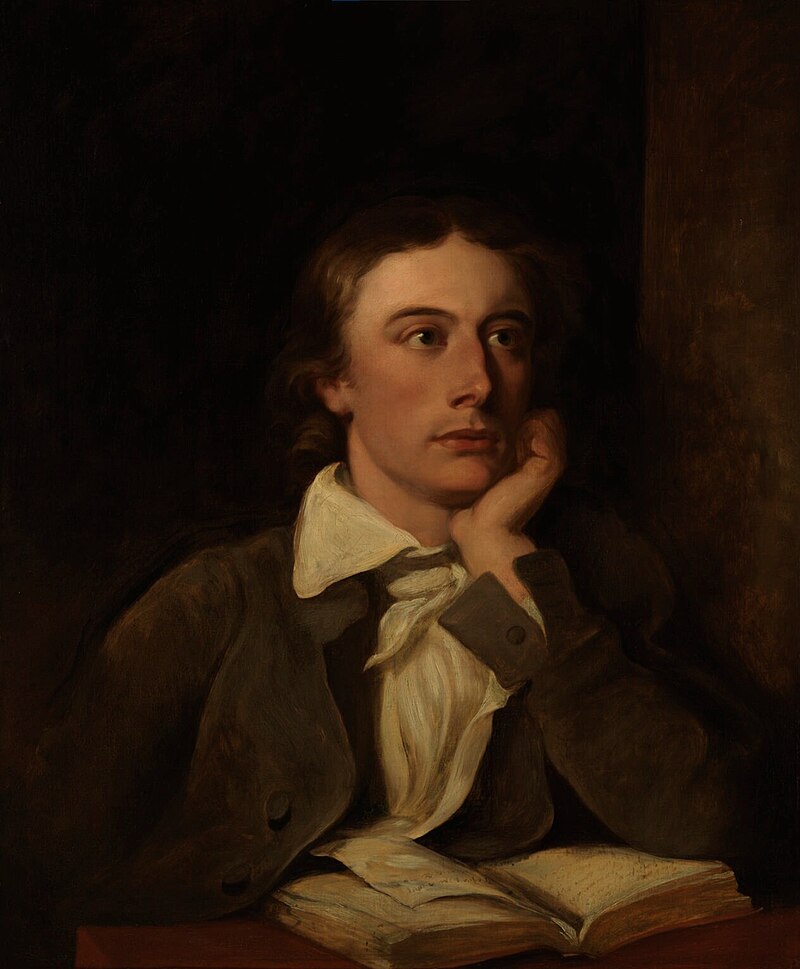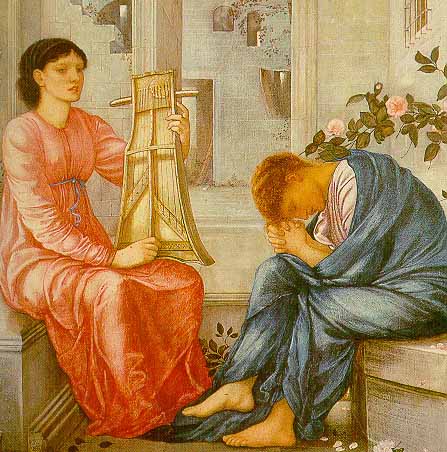Portrait of John Keats by William Hilton, after Joseph Severn (National Portrait Gallery, London)
Ode on Melancholy
No, no, go not to Lethe, neither twist
Wolf's-bane, tight-rooted, for its poisonous wine;
Nor suffer thy pale forehead to be kiss'd
By nightshade, ruby grape of Proserpine;
Make not your rosary of yew-berries,
Nor let the beetle, nor the death-moth be
Your mournful Psyche, nor the downy owl
A partner in your sorrow's mysteries;
For shade to shade will come too drowsily,
And drown the wakeful anguish of the soul.
But when the melancholy fit shall fall
Sudden from heaven like a weeping cloud,
That fosters the droop-headed flowers all,
And hides the green hill in an April shroud;
Then glut thy sorrow on a morning rose,
Or on the rainbow of the salt sand-wave,
Or on the wealth of globed peonies;
Or if thy mistress some rich anger shows,
Emprison her soft hand, and let her rave,
And feed deep, deep upon her peerless eyes.
She dwells with Beauty—Beauty that must die;
And Joy, whose hand is ever at his lips
Bidding adieu; and aching Pleasure nigh,
Turning to poison while the bee-mouth sips:
Ay, in the very temple of Delight
Veil'd Melancholy has her sovran shrine,
Though seen of none save him whose strenuous tongue
Can burst Joy's grape against his palate fine;
His soul shalt taste the sadness of her might,
And be among her cloudy trophies hung.
Summary
The reader is not to go to the underworld
(Lethe), nor to drink wolf's-bane (a poison), nor to take nightshade
(also a poison), nor to have anything to do with yew-berries, the
beetle, the death-moth, and the owl (all symbolic of death). Death and
all things associated with it numb the experience of anguish. When a
melancholy mood comes to the individual, he should feed it by observing
the beauty of roses, rainbows, and peonies. Or if the one he loves is
angry, let him hold her hand and feed on the loveliness of her eyes.
Melancholy dwells with beauty, "beauty that must die," joy, and
pleasure. It is to be found at the very heart of delight, but only the
strongly sensuous man perceives it there. He is the one who can have the
deepest experience of melancholy.
Analysis
The "Ode to Melancholy" belongs to a class of
eighteenth-century poems that have some form of melancholy as their
theme. Such poetry came to be called the "Graveyard School of Poetry"
and the best-known example of it is Thomas Gray's "Elegy in a Country
Churchyard." The romantic poets inherited this tradition. One of the
effects of this somber poetry about death, graveyards, the brevity of
pleasure and of life was a pleasing feeling of melancholy.
Keats' special variation on the theme was to make
the claim that the keenest experience of melancholy was to be obtained
not from death but from the contemplation of beautiful objects because
they were fated to die. Therefore the most sensuous man, the man who can
"burst Joy's grape against his palate fine," as Keats put it in a
striking image, is capable of the liveliest response to melancholy.
Keats' own experience of life and his individual temperament made him
acutely aware of the close relationship between joy and sorrow. His
happiness was constantly being chipped away by frustration. He was
himself a very sensuous individual. In the "Ode to Melancholy," Keats,
instead of rejecting melancholy, shows a healthy attraction toward it,
for unless one keenly experiences it, he cannot appreciate joy.
The abruptness with which "Ode to Melancholy"
begins is accounted for by the fact that the stanza with which the poem
begins was originally the second stanza.
The original first stanza was:
Though you should build a bark of dead men's bones,
And rear a phantom gibbet for a mast,
Stitch creeds together for a sail, with groans
To fill it out, blood-stained and aghast;
Although your rudder be a dragon's tail
Long sever'd, yet still hard with agony,
Your cordage large uprootings from the skull
Of bald Medusa, certes you would fail
To find the Melancholy — whether she
Dreameth in any isle of Lethe dull.
And rear a phantom gibbet for a mast,
Stitch creeds together for a sail, with groans
To fill it out, blood-stained and aghast;
Although your rudder be a dragon's tail
Long sever'd, yet still hard with agony,
Your cordage large uprootings from the skull
Of bald Medusa, certes you would fail
To find the Melancholy — whether she
Dreameth in any isle of Lethe dull.
We don't know why Keats rejected this original
beginning stanza, but we can guess. He was straining to create images of
death that would convey something of the repulsiveness of death — to
give the reader a romantic shudder of the Gothic kind — and what he
succeeded in doing was repulsive instead of delicately suggestive and
was out of keeping with what he achieved in the rest of the poem.
Moreover, he may have felt that two stanzas on death were more than
enough. The stanza is crude and Keats realized it.
The stanza with which Keats decided to begin the
poem is startling, but not crude. Keats brought together a remarkable
collection of objects in the stanza. Lethe is a river in the classical
underworld. Wolfsbane and nightshade are poisonous plants. The yew-berry
is the seed (also poisonous) of the yewtree, which, because it is hardy
and an evergreen, is traditionally planted in English graveyards.
Replicas of a black beetle were frequently placed in tombs by Egyptians;
to the Egyptians, the scarab or black beetle was a symbol of
resurrection, but to Keats they were a symbol of death because of their
association with tombs. The death-moth or butterfly represented the soul
leaving the body at death. The owl was often associated with
otherworldly symbols because of its nocturnal habits and its ominous
hooting. Death is the common denominator of the displays in Keats'
museum of natural history. The language of the stanza is vastly superior
to that of the discarded stanza. Nothing in it can compare with calling
nightshade the "ruby grape of Proserpine," the queen of the underworld,
nor with making a rosary of yew-berries and thereby automatically
suggesting prayers for the dying or the dead. The stanza is one of the
richest and strangest in Keats' poetry.


No comments:
Post a Comment